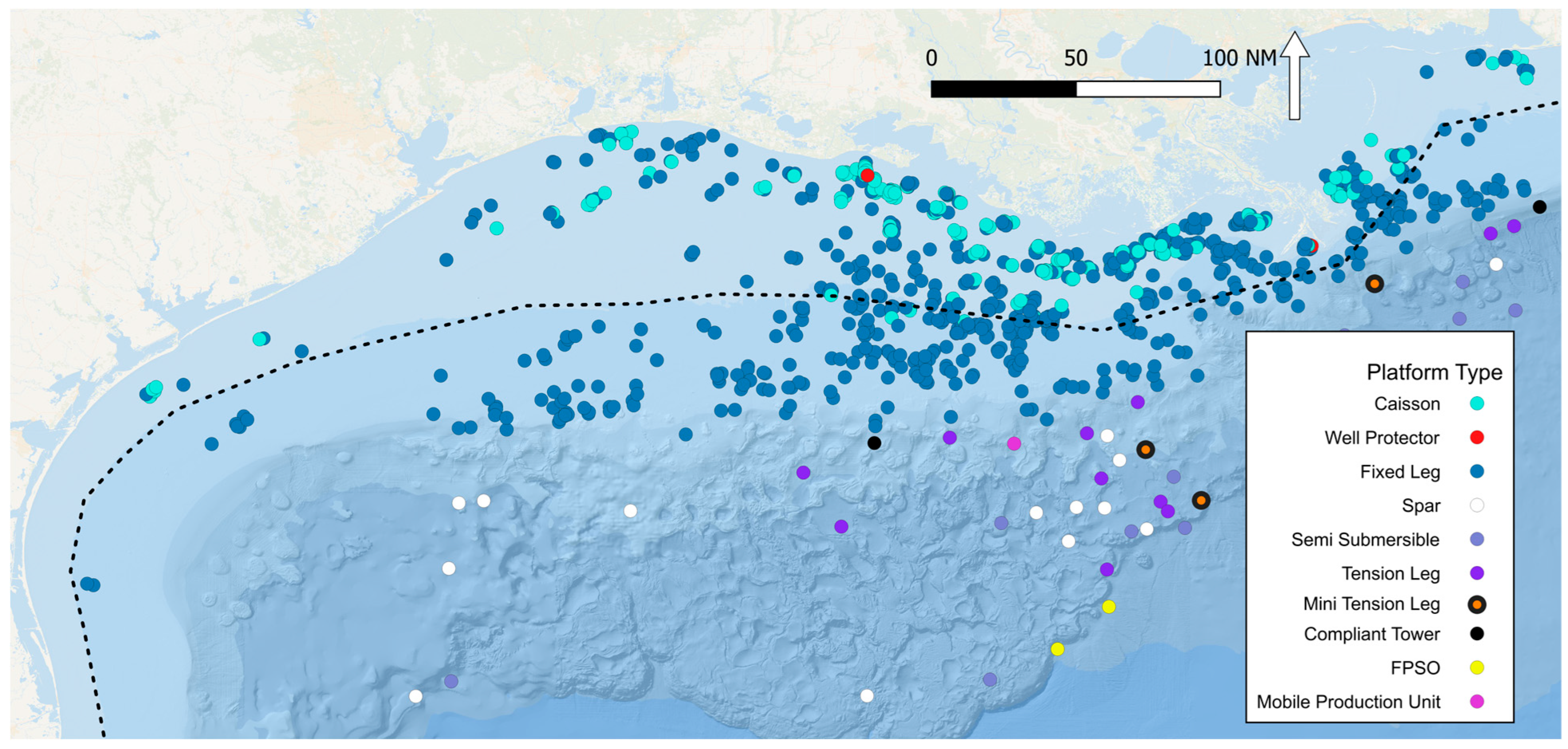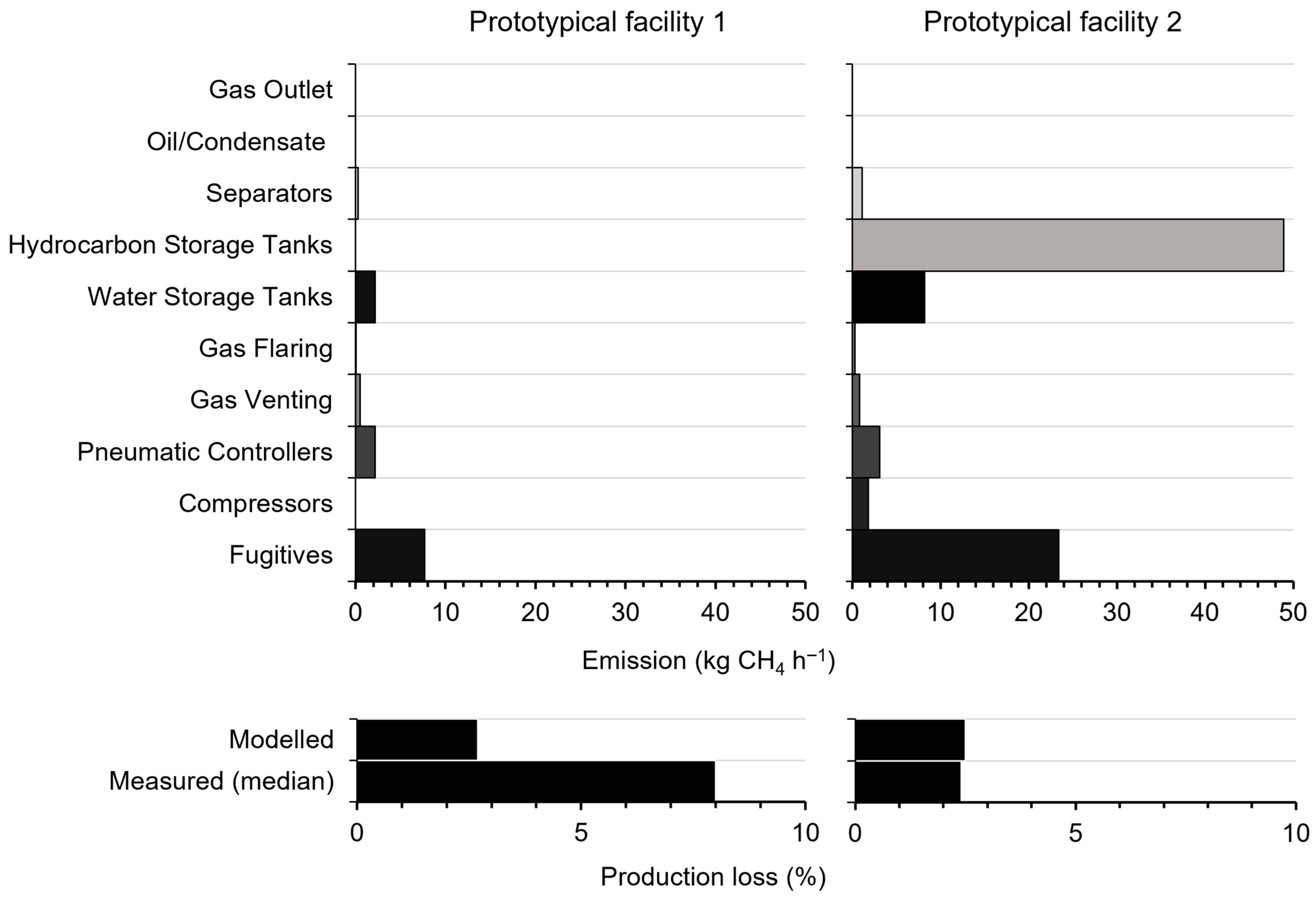Calculating Methane Emissions from Offshore Facilities Using Bottom-Up Methods
Abstract
1. Introduction
2. Materials and Methods
2.1. Distribution of Operating Facilities in the Gulf of Mexico
2.2. Calculating Emissions from a Facility Operating Normally
2.3. Estimating Fugitive Emissions
2.4. Maintenance Emissions
2.5. Large Upset Emissions
2.6. Comparison with Observed Emissions
3. Results
3.1. Emissions from a Facility Operating Normally
3.1.1. Prototypical Facility Type 1
3.1.2. Prototypical Facility Type 2
3.1.3. Note of Caution with Data
3.2. Fugitive Emissions
3.3. Observed Emissions
3.3.1. Prototypical Type 1 Facilities
3.3.2. Prototypical Type 2 Facilities
4. Discussion
4.1. Calculated Bottom-Up Emission Estimates
4.2. Measured Emissions
4.3. Recognizing Real Large Emission Events and Quantification Best Practices
4.4. Future Use of the Bottom-Up Emission Estimates
5. Conclusions
Supplementary Materials
Author Contributions
Funding
Institutional Review Board Statement
Informed Consent Statement
Data Availability Statement
Conflicts of Interest
References
- OGMP Oil and Gas Methane Partnership 2.0—Key Benefits. Available online: https://www.ogmpartnership.org/key-benefits (accessed on 17 June 2025).
- Cheniere Converting Measurements into Measurement Informed Inventories: Lessons from Cheniere’s. QMRV Research Series. Global Methane Initiative, Geneva March 20, 2024. Available online: https://www.globalmethane.org/documents/2024Forum/Oil%20&%20Gas%20Sessions/3%20-%20The%20Role%20of%20Technologies%20in%20Improving%20Measurements%20and%20Enhancing%20Inventories%20to%20Enable%20Faster%20Action/8%20-%20George_MRV_Oil%20&%20Gas.pdf (accessed on 17 June 2025).
- BOEM Bureau of Ocean Energy Management (BOEM) OCS Emissions Inventory—2017. Available online: https://www.boem.gov/environment/environmental-studies/ocs-emissions-inventory-2017 (accessed on 4 February 2025).
- Chen, Z.; Yacovitch, T.I.; Daube, C.; Herndon, S.C.; Wilson, D.; Enoch, S.; Allen, D.T. Reconciling Methane Emission Measurements for Offshore Oil and Gas Platforms with Detailed Emission Inventories: Accounting for Emission Intermittency. ACS Environ. Au 2023, 3, 87–93. [Google Scholar] [CrossRef] [PubMed]
- Riddick, S.N.; Mauzerall, D.L. Likely Substantial Underestimation of Reported Methane Emissions from United Kingdom Upstream Oil and Gas Activities. Energy Environ. Sci. 2023, 16, 295–304. [Google Scholar] [CrossRef]
- Ayasse, A.K.; Thorpe, A.K.; Cusworth, D.H.; Kort, E.A.; Negron, A.G.; Heckler, J.; Asner, G.; Duren, R.M. Methane Remote Sensing and Emission Quantification of Offshore Shallow Water Oil and Gas Platforms in the Gulf of Mexico. Environ. Res. Lett. 2022, 17, 084039. [Google Scholar] [CrossRef]
- Foulds, A.; Allen, G.; Shaw, J.T.; Bateson, P.; Barker, P.A.; Huang, L.; Pitt, J.R.; Lee, J.D.; Wilde, S.E.; Dominutti, P.; et al. Quantification and Assessment of Methane Emissions from Offshore Oil and Gas Facilities on the Norwegian Continental Shelf. Atmos. Chem. Phys. 2022, 22, 4303–4322. [Google Scholar] [CrossRef]
- Gorchov Negron, A.M.; Kort, E.A.; Chen, Y.; Brandt, A.R.; Smith, M.L.; Plant, G.; Ayasse, A.K.; Schwietzke, S.; Zavala-Araiza, D.; Hausman, C.; et al. Excess Methane Emissions from Shallow Water Platforms Elevate the Carbon Intensity of US Gulf of Mexico Oil and Gas Production. Proc. Natl. Acad. Sci. USA 2023, 120, e2215275120. [Google Scholar] [CrossRef] [PubMed]
- Gorchov Negron, A.M.; Kort, E.A.; Conley, S.A.; Smith, M.L. Airborne Assessment of Methane Emissions from Offshore Platforms in the U.S. Gulf of Mexico. Environ. Sci. Technol. 2020, 54, 5112–5120. [Google Scholar] [CrossRef] [PubMed]
- Hensen, A.; Velzeboer, I.; Frumau, K.F.A.; van den Bulk, W.C.M.; van Dinter, D. Methane Emission Measurements of Offshore Oil and Gas Platforms; TNO: Petten, The Netherlands, 2019; p. 94. [Google Scholar]
- Irakulis-Loitxate, I.; Gorroño, J.; Zavala-Araiza, D.; Guanter, L. Satellites Detect a Methane Ultra-Emission Event from an Offshore Platform in the Gulf of Mexico. Environ. Sci. Technol. Lett. 2022, 9, 520–525. [Google Scholar] [CrossRef]
- Khaleghi, A.; MacKay, K.; Darlington, A.; James, L.A.; Risk, D. Methane Emission Rate Estimates of Offshore Oil Platforms in Newfoundland and Labrador, Canada. Elem. Sci. Anthr. 2024, 12, 00025. [Google Scholar] [CrossRef]
- MacLean, J.-P.W.; Girard, M.; Jervis, D.; Marshall, D.; McKeever, J.; Ramier, A.; Strupler, M.; Tarrant, E.; Young, D. Offshore Methane Detection and Quantification from Space Using Sun Glint Measurements with the GHGSat Constellation. Atmos. Meas. Tech. 2024, 17, 863–874. [Google Scholar] [CrossRef]
- Nara, H.; Tanimoto, H.; Tohjima, Y.; Mukai, H.; Nojiri, Y.; Machida, T. Emissions of Methane from Offshore Oil and Gas Platforms in Southeast Asia. Sci. Rep. 2015, 4, 6503. [Google Scholar] [CrossRef]
- Pühl, M.; Roiger, A.; Fiehn, A.; Gorchov Negron, A.M.; Kort, E.A.; Schwietzke, S.; Pisso, I.; Foulds, A.; Lee, J.; France, J.L.; et al. Aircraft-Based Mass Balance Estimate of Methane Emissions from Offshore Gas Facilities in the Southern North Sea. Atmos. Chem. Phys. 2024, 24, 1005–1024. [Google Scholar] [CrossRef]
- Riddick, S.N.; Mauzerall, D.L.; Celia, M.; Harris, N.R.P.; Allen, G.; Pitt, J.; Staunton-Sykes, J.; Forster, G.L.; Kang, M.; Lowry, D.; et al. Methane Emissions from Oil and Gas Platforms in the North Sea. Atmos. Chem. Phys. 2019, 19, 9787–9796. [Google Scholar] [CrossRef]
- Valverde, A.; Irakulis-Loitxate, I.; Roger, J.; Gorroño, J.; Guanter, L. Satellite Characterization of Methane Point Sources by Offshore Oil and Gas PlatForms. Environ. Sci. Proc. 2023, 28, 22. [Google Scholar]
- Yacovitch, T.I.; Daube, C.; Herndon, S.C. Methane Emissions from Offshore Oil and Gas Platforms in the Gulf of Mexico. Environ. Sci. Technol. 2020, 54, 3530–3538. [Google Scholar] [CrossRef] [PubMed]
- Riddick, S.N.; Mbua, M.; Laughery, C.; Zimmerle, D.J. A Review of Offshore Methane Quantification Methodologies. Atmosphere 2025, 16, 626. [Google Scholar] [CrossRef]
- Statistica Number of Offshore Rigs Worldwide as of January 2018 by Region. Available online: https://www.statista.com/statistics/279100/number-of-offshore-rigs-worldwide-by-region/ (accessed on 28 December 2021).
- EIA Offshore Production Nearly 30% of Global Crude Oil Output in 2015. Available online: https://www.eia.gov/todayinenergy/detail.php?id=28492 (accessed on 28 December 2021).
- EIA Natural Gas Explained. Available online: https://www.eia.gov/energyexplained/natural-gas/use-of-natural-gas.php (accessed on 12 October 2021).
- BSEE Bureau of Safety and Environmental Enforcement (BSEE) Data Center. Available online: https://www.data.bsee.gov/Main/Default.aspx (accessed on 4 February 2025).
- Speight, J. Processing Gas from Tight Formations. In Shale Oil and Gas Production Processes; Elsevier: Amsterdam, The Netherlands, 2020; pp. 451–518. ISBN 978-0-12-813315-6. [Google Scholar]
- Lyons, W.C.; Plisga, G.J.; Lorenz, M.D. (Eds.) Standard Handbook of Petroleum and Natural Gas Engineering, 3rd ed.; Gulf Professional Publishing: Amsterdam, The Netherlands; Boston, MA, USA, 2016; ISBN 978-0-12-383846-9. [Google Scholar]
- EPA Inventory of U.S. Greenhouse Gas Emissions and Sinks: 1990–2016. 2018. Available online: https://www.epa.gov/ghgemissions/inventory-us-greenhouse-gas-emissions-and-sinks-1990-2016 (accessed on 5 May 2023).
- US EPA U.S. Environmental Protection Agency, AP-42: Compilation of Air Emissions Factors. 2018. Available online: https://www3.epa.gov/ttn/chief/ap42/ch13/final/C13S05_02-05-18.pdf (accessed on 25 October 2022).
- US EPA US Environmental Protection Agency. Methane Emissions from the Natural Gas Industry, Volume 3: General Methodology. Available online: https://www.epa.gov/sites/default/files/2016-08/documents/3_generalmeth.pdf (accessed on 6 December 2024).
- US EPA, O. GHGRP Reported Data. Available online: https://www.epa.gov/ghgreporting/ghgrp-reported-data (accessed on 21 January 2020).
- NAEI National Atmospheric Emissions Inventory. UK Greenhouse Gas Emissions Statistics. 2021. Available online: https://naei.beis.gov.uk/data/data-selector?Q=152412 (accessed on 16 June 2023).
- Riddick, S.N.; Mbua, M.; Santos, A.; Hartzell, W.; Zimmerle, D.J. Potential Underestimate in Reported Bottom-up Methane Emissions from Oil and Gas Operations in the Delaware Basin. Atmosphere 2024, 15, 202. [Google Scholar] [CrossRef]
- Varon, D.J.; Jacob, D.J.; Hmiel, B.; Gautam, R.; Lyon, D.R.; Omara, M.; Sulprizio, M.; Shen, L.; Pendergrass, D.; Nesser, H.; et al. Continuous Weekly Monitoring of Methane Emissions from the Permian Basin by Inversion of TROPOMI Satellite Observations. Atmos. Chem. Phys. 2023, 23, 7503–7520. [Google Scholar] [CrossRef]
- Riddick, S.N.; Cheptonui, F.; Yuan, K.; Mbua, M.; Day, R.; Vaughn, T.L.; Duggan, A.; Bennett, K.E.; Zimmerle, D.J. Estimating Regional Methane Emission Factors from Energy and Agricultural Sector Sources Using a Portable Measurement System: Case Study of the Denver–Julesburg Basin. Sensors 2022, 22, 7410. [Google Scholar] [CrossRef]
- Zavala-Araiza, D.; Alvarez, R.A.; Lyon, D.R.; Allen, D.T.; Marchese, A.J.; Zimmerle, D.J.; Hamburg, S.P. Super-Emitters in Natural Gas Infrastructure Are Caused by Abnormal Process Conditions. Nat. Commun. 2017, 8, 14012. [Google Scholar] [CrossRef] [PubMed]
- Vaughn, T.L.; Bell, C.S.; Pickering, C.K.; Schwietzke, S.; Heath, G.A.; Pétron, G.; Zimmerle, D.J.; Schnell, R.C.; Nummedal, D. Temporal Variability Largely Explains Top-down/Bottom-up Difference in Methane Emission Estimates from a Natural Gas Production Region. Proc. Natl. Acad. Sci. USA 2018, 115, 11712–11717. [Google Scholar] [CrossRef] [PubMed]


| Prototypical Facility Type | Average Number of Producing Well Heads Per Facility | Average Water Production (Mbbl y−1 well−1) | Average Gas Production (MMscf y−1 well−1) | Average Gas Production (kg h−1 facility−1) | Average Oil Production (Mbbl y−1 well−1) |
|---|---|---|---|---|---|
| 1 | 2.6 | 114 | 87 | 480 | 25 |
| 2 | 4.0 | 357 | 411 | 3495 | 566 |
| Platform Type | Count | Average Install Date | Average Deck Count | Manned 24 Hours Per Day (%) | With a Compressor (%) | With a Generator (%) | With Production Equipment (%) | With a Storage Tank (%) |
|---|---|---|---|---|---|---|---|---|
| Caisson | 253 | 1992 | 1.7 | 1 | 2 | 4 | 72 | 2 |
| Well Protector | 6 | 1983 | 1.0 | 0 | 0 | 0 | 50 | 0 |
| Fixed Leg | 806 | 1982 | 2.3 | 23 | 38 | 47 | 84 | 28 |
| Spar Platform | 17 | 2005 | 3.4 | 94 | 100 | 100 | 100 | 65 |
| Semi-Submersible | 15 | 2014 | 1.7 | 93 | 93 | 93 | 93 | 73 |
| Tension leg | 14 | 2003 | 2.5 | 100 | 100 | 100 | 100 | 93 |
| Mini Tension Leg | 3 | 2003 | 3.3 | 100 | 100 | 100 | 100 | 67 |
| Compliant tower | 2 | 1999 | 3.5 | 100 | 100 | 100 | 100 | 100 |
| FPSO | 2 | 2013 | 0.0 | 100 | 100 | 100 | 100 | 100 |
| Mobile Prod. Unit | 1 | 2009 | 3.0 | 100 | 100 | 100 | 100 | 100 |
| Type | Number Platforms Surveyed | Average # Fugitives | Average Total Emission (kg h−1) | Average Emission per Leak (kg h−1) |
|---|---|---|---|---|
| Fixed Leg | 43 | 12 | 7.7 | 0.64 |
| FPSO | 1 | 4 | 11.9 | 2.99 |
| Semi-Submersible | 3 | 18 | 28.3 | 1.57 |
| Spar | 3 | 16 | 20.8 | 1.30 |
| Tension Leg | 4 | 15 | 21.4 | 1.42 |
Disclaimer/Publisher’s Note: The statements, opinions and data contained in all publications are solely those of the individual author(s) and contributor(s) and not of MDPI and/or the editor(s). MDPI and/or the editor(s) disclaim responsibility for any injury to people or property resulting from any ideas, methods, instructions or products referred to in the content. |
© 2025 by the authors. Licensee MDPI, Basel, Switzerland. This article is an open access article distributed under the terms and conditions of the Creative Commons Attribution (CC BY) license (https://creativecommons.org/licenses/by/4.0/).
Share and Cite
Riddick, S.N.; Mbua, M.; Laughery, C.; Zimmerle, D.J. Calculating Methane Emissions from Offshore Facilities Using Bottom-Up Methods. Eng 2025, 6, 199. https://doi.org/10.3390/eng6080199
Riddick SN, Mbua M, Laughery C, Zimmerle DJ. Calculating Methane Emissions from Offshore Facilities Using Bottom-Up Methods. Eng. 2025; 6(8):199. https://doi.org/10.3390/eng6080199
Chicago/Turabian StyleRiddick, Stuart N., Mercy Mbua, Catherine Laughery, and Daniel J. Zimmerle. 2025. "Calculating Methane Emissions from Offshore Facilities Using Bottom-Up Methods" Eng 6, no. 8: 199. https://doi.org/10.3390/eng6080199
APA StyleRiddick, S. N., Mbua, M., Laughery, C., & Zimmerle, D. J. (2025). Calculating Methane Emissions from Offshore Facilities Using Bottom-Up Methods. Eng, 6(8), 199. https://doi.org/10.3390/eng6080199







